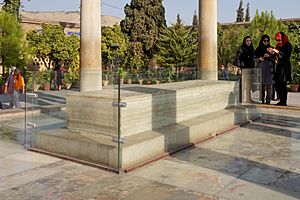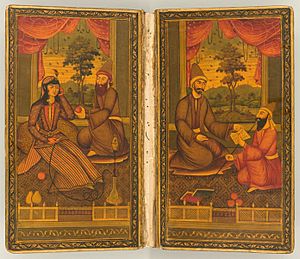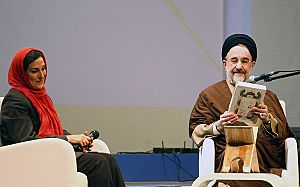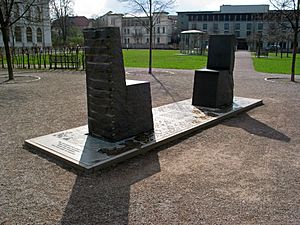Hafez facts for kids
Quick facts for kids Hafez |
|
|---|---|

A painting of Hafez by Abolhassan Sadighi.
|
|
| Spiritual poet, mystic | |
| Born | circa. 1325 Shiraz, Muzaffarid Persia |
| Died | 1390 (aged 64–65) Shiraz, Timurid Empire (present-day Iran) |
| Major shrine | Tomb of Hafez, Shiraz, Iran |
| Influences | Ibn Arabi, Khwaju, Al-Hallaj, Sanai, Anvari, Nizami, Sa'di, Khaqani, Attar |
| Influenced | Subsequent Persian lyric poets, Goethe |
|
Tradition or genre
|
Mystic poetry (Ghazal, Irfan) |
| Major works | The Divān of Hafez |
Khwāje Shams-od-Dīn Moḥammad Ḥāfeẓ-e Shīrāzī (Persian: خواجه شمسالدین محمّد حافظ شیرازی), known as Hafez (حافظ, Ḥāfeẓ), was a famous Persian poet. His works are seen as some of the best in Persian literature.
Many people in Persian-speaking countries have his poems at home. They often learn them by heart and use them as everyday sayings. Hafez's life and poems have been studied a lot. He has influenced Persian writing more than any other author since the 14th century.
Hafez is most famous for his Divan of Hafez. This is a collection of his poems that were likely put together after he died. His poems are often called "mystical" or "theosophical." In his time, "theosophy" meant spiritual writings inspired by holy books. Hafez mainly wrote ghazals, which are a type of lyric poetry. This style was perfect for showing deep spiritual feelings, often like love poems. He was also a Sufi, which is a branch of Islam focused on spiritual closeness to God.
His ghazals often talk about love, wine, and taverns. These themes represent joy and freedom, whether in real life or as symbols of divine love. Hafez's influence is still strong today. People sometimes use his poems for fortune-telling (called fāl-e hāfez). His poems are also used in Persian traditional music, art, and Persian calligraphy. His tomb is in Shiraz, where he was born. You can find his poems translated into many languages around the world.
Contents
Life of Hafez


Hafez was born in Shiraz, Iran, around 1315 or 1317. We don't know many details about his early life. What we know often comes from old stories.
When he was young, he memorized the entire Quran. Because of this, he was given the title Hafez, which means 'the memorizer' or 'the keeper'. He later used this as his pen name.
Hafez was a Sufi Muslim. He was supported by different rulers during his life. This support is called patronage. These rulers included Shah Abu Ishaq and Shah Shuja. His work was most popular during the 27-year rule of Shah Shuja. It is said that Hafez briefly had problems with Shah Shuja because he made fun of other poets. Shah Shuja also wrote poetry, so he might have taken it personally. This might have made Hafez leave Shiraz for a short time. Hafez also wrote letters and poems to Ghiyasuddin Azam Shah, the Sultan of Bengal. The Sultan even invited him to his kingdom, but Hafez could not go.
Hafez died in 1390. About 20 years after his death, a special tomb was built for him in Shiraz. This tomb is called the Hafezieh. The current building was designed by a French architect in the 1930s. Hafez's tomb is on a raised platform, surrounded by rose gardens and orange trees. Inside, two of his poems are carved into his stone coffin.
Stories About Hafez
Many amazing stories were told about Hafez after he died. One story says that he learned the entire Quran by heart just by listening to his father recite it. This is how he earned the name Hafez. He is also said to have known the works of other great poets like Rumi and Saadi by heart.
Another story tells that Hafez worked in a bakery when he was young. He delivered bread to a rich part of town. There, he saw a very beautiful woman named Shakh-e Nabat. Some of his poems are believed to be about her. He knew she would not love him back. So, he started a spiritual journey, hoping to find a deeper, divine love.
When he was 60, Hafez is said to have done a special 40-day and 40-night spiritual practice. He sat inside a circle he had drawn for himself. On the last day, he met his Sufi teacher, Zayn al-Attar, and was offered a cup of wine. This moment is said to be when he reached a very high level of spiritual understanding. He mentions this in one of his poems, advising people to let wine "sit for 40 days" to get its "clarity." This is a symbol for spiritual growth.
There's also a famous tale about Hafez and Tamerlane, a powerful ruler. Tamerlane was angry about one of Hafez's poems:
|
'agar 'ān Tork-e Šīrāzī * be dast ārad del-ē mā-rā |
If that Shirazi Turk accepts my heart in their hand, |
Samarkand was Tamerlane's capital, and Bukhara was a very important city. Tamerlane complained, "I have fought and conquered most of the world to make Samarkand and Bukhara beautiful. And you would give them away for a mole on some girl's face in Shiraz!"
Hafez, the story goes, bowed and replied, "Oh Prince, it is this generosity that has made me so poor!" Tamerlane was so surprised and pleased by this clever answer that he gave Hafez many gifts.
Hafez's Influence
Hafez was famous throughout the Islamic world during his lifetime. Other Persian poets copied his style. Rulers from places like Baghdad to India offered him support.
His work was first translated into English in 1771. It later influenced many Western writers. These included Henry David Thoreau, Johann Wolfgang von Goethe, and Ralph Waldo Emerson. Emerson even called him "a poet's poet." The famous detective Sherlock Holmes also mentioned Hafez in a story, saying he had "as much sense... and as much knowledge of the world."
There isn't one perfect version of his collected poems, called the Dīvān. Different editions have different numbers of poems. Scholars have worked hard to find the most accurate versions.
In Modern Iranian Culture
Hafez is the most loved poet in Iran today. You can find his books in almost every Iranian home. In fact, October 12 is celebrated as Hafez Day in Iran.

His tomb is very popular. Many people visit it, and the atmosphere is lively. Visitors often sing and recite their favorite Hafez poems.
Many Iranians use the Divan of Hafez for fortune telling. During holidays like Nowruz (Persian New Year) or Yalda, families open the Divan to a random page. They read the poem there, believing it tells them about the future.
In Iranian and Afghan Music
Hafez's poems are very popular in Persian traditional music. Along with Sa'di, he is one of the most sung poets. Many modern composers have created songs based on his ghazals. These songs have become very popular in classical music. Famous singers like Hayedeh have performed songs using his poems.
In Afghan music, many singers, including Ahmad Zahir, have also composed songs using Hafez's poems.
Satire and Politics in Hafez's Poetry

While Hafez is known for his beautiful poetry, he also made important intellectual and political points. A key part of his poems is their ironic tone and the theme of hypocrisy. Many believe he used these to criticize the religious and ruling powers of his time.
Persian satire grew popular in the 14th century. Hafez and other writers used humor to point out problems in society. Many of his criticisms were aimed at the ruler Mubariz al-Din Muhammad. He especially focused on how important public and private systems were breaking down.
Hafez's work often made imaginative references to monasteries and convents. He ignored some of the religious rules of his time. He even found humor in some of his society's religious beliefs. Using humor to make a point has become a common way to talk about social issues in Iran.
Divan-e-Hafez
Divan Hafez is a book that contains all of Hafez's poems that still exist. Most of these poems are in Persian. The most important part of this Divan is his ghazals. The book also includes other types of poems.
It seems that Hafez was not a poet who wrote a huge number of poems. He was very famous during his lifetime, but the number of poems in his Divan is not very large. This suggests he focused on quality over quantity.
The Divan of Hafez was probably put together by Mohammad Golandam after Hafez died. However, some stories say that Hafez himself edited his collection more than 20 years before his death.
Death and Tomb
Hafez died in the year 791 AH (around 1390 CE). He was buried in a prayer hall in Shiraz, which is now known as the Hafezieh. In 855 AH, after Shiraz was conquered by Abolghasem Babar Teymouri, a tomb was built for Hafez. This was ordered by his minister, Maulana Mohammad Mamaei.
Poems by Hafez
Here are some of Hafez's famous poems:
- Alā yā ayyoha-s-sāqī
- Dūš dīdam ke malā'ek
- Goftā borūn šodī
- Mazra'-ē sabz-e falak
- Naqdhā rā bovad āyā
- Sālhā del talab-ē jām
- Shirazi Turk
- Sīne mālāmāl
- Zolf-'āšofte
See also
 In Spanish: Hafez de Shiraz para niños
In Spanish: Hafez de Shiraz para niños
- Diwan (poetry)
- List of Persian poets and authors
- Persian metres
- Persian mysticism
- Rumi, Persian poet
- Persian literature
- The Love Songs of Hafiz
- West-östlicher Diwan

